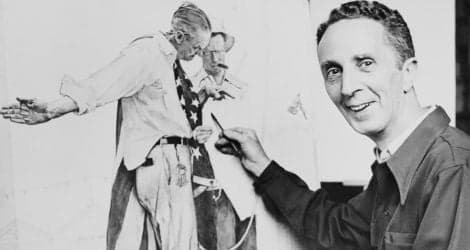

Buy Norman Rockwell superb reproductions hand-painted on canvas with oil painting, rivaling with the master quality. Choose between dozens of artwork.
We give special attention to your paintings on canvas to make sure it will be exceptional. Our beautiful reproductions of Norman Rockwell artworks are of the best quality money can buy, and are works of art that you will be able to keep for ages to come.
Our philosophy is to focus on a strict follow-up of the art processing to ensure your satisfaction. We aim to increase our customer base and maintain customer loyalty through confidence in our products and a continued high quality of service.

Our high quality oil painting replicas are hand-painted on the best canvas with top-quality pigments. Oil painting reproductions are used for interior design to embelish your home, or your place of business.
Our reproductions are of the highest quality available on the market, and are a real tribute to the original artist. Only senior artists with more than 20 years of experience are working on your painting, top-of-the-line paint and canvases are used. Try the difference; you'll never order anywhere else after that. For the discerning art connoisseur, 100 percent satisfaction is guaranteed.
Rockwell's portrayal encapsulated the quintessential representation of the "all-American" identity. The primary focus of his remembrance lies in his extensive 47-year affiliation with The Saturday Evening Post, a prominent weekly publication, during which he produced over 320 cover images. Additionally, he maintained a longstanding relationship with the Boy Scouts of America, creating artworks for their annual calendar throughout the most of his professional career. The author's intense focus on the intricate details of the everyday experiences of the American nuclear family, as well as his significant role in shaping World War II propaganda, have propelled him to attain the esteemed status of an American legend.
The artist in question, rather than being categorized as an illustrator, identifies himself as a genre painter. He has gained notable recognition for a distinct style of painting, rather than individual pieces. Similar to Edward Hopper, his portrayal of the American small town has permeated the collective awareness of the nation. Despite facing criticism from avant-gardists and left-wing intellectuals due to his overt patriotism and visual manner, the latter works of the artist demonstrated the impact of Social Realism. Notably, his mature pieces, particularly those created for Look magazine, exhibited a heightened socio-political dimension. The field of history has consistently recognized and valued Rockwell's significant impact on the visual arts in the United States. His evocative images, which evoke nostalgia, are still prominently featured on various items such as calendars, postcards, posters, and other forms of artistic ephemera.
Rockwell, being a devout adherent to religion and traditional beliefs, primarily identified himself as a patriot. His perspective was characterized by empathy and a positive outlook on the typical American citizen. Among all artists throughout its history, he was unparalleled in his ability to depict the ordinary practices and ceremonies associated with the attractive and customary aspects of traditional American familial existence.
Despite being regarded as merely an illustrator by certain individuals, Rockwell adeptly depicted his scenes with a combination of comedy and reverence for his themes. Furthermore, he demonstrated a meticulousness in his work, as he strived to evoke a simultaneous sense of wistfulness and joy in the viewer, as he himself expressed. During a period characterized by the rise of abstract painting, Rockwell maintained his belief that his optimistic and unequivocal imagery surpassed the self-gratifying nature of abstract experimentation.
Clement Greenberg, a prominent advocate of Abstract Expressionism, expressed disapproval towards Rockwell's artwork, citing its sentimental and commercial nature. Greenberg further criticized the artist for his perceived lack of seriousness in his artistic pursuits. However, Rockwell shown a profound dedication to his artistic endeavors. The stance held by the individual in question was effectively encapsulated by his own granddaughter, Abigail Rockwell, who articulated that "certain individuals assert that existence can never attain the level of flawlessness depicted in a Norman Rockwell painting." However, the focus of my grandfather's art does not revolve around an unattainable ideal. Pop's art is around the concept of placing faith in the inherent benevolence of individuals. The essence of this concept lies in the pursuit of identifying and acknowledging the inherent virtue within ourselves, as well as within others, and in the shared experiences we encounter during our interactions.
While Rockwell consistently expressed his desire to entertain, his latter works frequently advocated for issues such as the promotion of freedom of speech and the advancement of the Civil Rights Movement. Throughout his adult life, the artist's unabashedly romantic paintings began to recognize the changing dynamics of class and gender roles, but he consistently advocated for democratic values and the inclusion of individuals from all races and religions.
Similar to the utilization of the camera obscura by artists such as Vermeer and Caravaggio to facilitate the creation of their compositions, Rockwell employed photography as a means to capture a visual representation of his subjects. Despite the fact that Rockwell mostly used his relatives and acquaintances as models, he used a limited group of photographers who would capture scenarios that the artist himself would carefully arrange and orchestrate. Rockwell's artistic process, which involved using a projector to trace and sketch pictures onto his canvas prior to creating his detailed story paintings, was met with disapproval from purists who adhered to the belief that art should always be done "freehand."